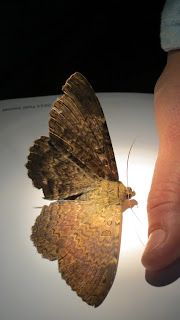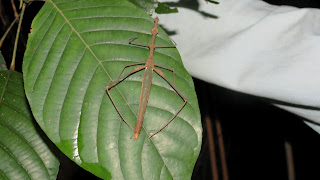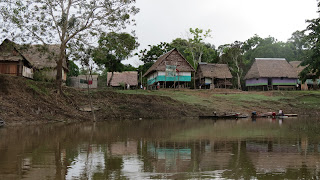Good Morning Rainforest!
The restooms are pit toilets a short walk away from the dorm rooms. At night you wish the restrooms were closer but the smell makes you appreicate the distance!
 Once our teeth, are brushed, faced washed and hair combed, we head for the boat dock to get into the boats for our early morning birding adventure. The village folks are just starting to stir as the sun comes up.
Once our teeth, are brushed, faced washed and hair combed, we head for the boat dock to get into the boats for our early morning birding adventure. The village folks are just starting to stir as the sun comes up.  The birds break the peace and quiet of the early morning. By 6am we are on the river and moving quickly down steam by the fast paced current. The birds are pretty active in the early morning looking for breakfast. Due to the lack of sunlight, only bird silhouettes are visible. Their true colors remain
The birds break the peace and quiet of the early morning. By 6am we are on the river and moving quickly down steam by the fast paced current. The birds are pretty active in the early morning looking for breakfast. Due to the lack of sunlight, only bird silhouettes are visible. Their true colors remain
By 7:30am we are back at the lodge eating breakfast. As we sit and eat our meal the soft conversation over breakfast is interupted by a troop of monkeys who have come to greet us. In no time the chairs are pushed back and the room cleared of every person as we race out of the lodge to view our new visitors. These squirrel monkeys are talkative and active. They quickly jump from tree to tree running up branches and chasing each other. They are clearing the tree of its fruits. Their activity creates enough noise to get everyone's attention and soon they are more viewers than monkeys!
 Our morning adventure is a visit to the village medical clinic. The American doctor came to the Amazon for a simple visit and a year later returned with the pledge and dedication to build a medical clinic and to be the village doctor. Today the clinic is a memoral to her vision and the dedication of many.
Our morning adventure is a visit to the village medical clinic. The American doctor came to the Amazon for a simple visit and a year later returned with the pledge and dedication to build a medical clinic and to be the village doctor. Today the clinic is a memoral to her vision and the dedication of many.
The clinic is a joint effort by many who believed in the need for a village medical clinic and medical services. Locals travel by foot and/or boat to see the doctor. The clinic addresses prevented medicine treatments and emergencies. The doctor has office hours but since she is the only doctor she is on call 24 /7.
The clinic addresses prevented medicine treatments and emergencies. The doctor has office hours but since she is the only doctor she is on call 24 /7.
 The clinic addresses prevented medicine treatments and emergencies. The doctor has office hours but since she is the only doctor she is on call 24 /7.
The clinic addresses prevented medicine treatments and emergencies. The doctor has office hours but since she is the only doctor she is on call 24 /7. One of the two treatment rooms. The rooms are spacious with beautiful rainforest wood cabinets. The facilities do not lack beauty and quality of design but they do lack medical materials and equipment. The doctor does her best to provide quality medical services with the materials she has.
One of the two treatment rooms. The rooms are spacious with beautiful rainforest wood cabinets. The facilities do not lack beauty and quality of design but they do lack medical materials and equipment. The doctor does her best to provide quality medical services with the materials she has.  After lunch we take a short walk through the rainforest to visit the local Shaman and the medicinal garden. The walk through the rainforest is beautiful. While still early morning, the damp air causes our clothes to stick to our skin. Perspiration quickly developes and in no time our clothing shows the signs of our hiking efforts. Filtered light barely reaches the rainforest floor due to the thick canopy. Leaf litter softens the sounds of our footsteps as we make our way to the Ethnobotanical Gardens. The rainforest is a natural masterpiece.
After lunch we take a short walk through the rainforest to visit the local Shaman and the medicinal garden. The walk through the rainforest is beautiful. While still early morning, the damp air causes our clothes to stick to our skin. Perspiration quickly developes and in no time our clothing shows the signs of our hiking efforts. Filtered light barely reaches the rainforest floor due to the thick canopy. Leaf litter softens the sounds of our footsteps as we make our way to the Ethnobotanical Gardens. The rainforest is a natural masterpiece. At the Gardens, we learn what plants are used by the local villiagers to treat health issues and what aliments the differet plants treat. Rather the plant is made into a tea to drink for a headache or the plant is chewed to get rid of a tooth ache, the local shaman treats the illnesses of the tribal people.
At the Gardens, we learn what plants are used by the local villiagers to treat health issues and what aliments the differet plants treat. Rather the plant is made into a tea to drink for a headache or the plant is chewed to get rid of a tooth ache, the local shaman treats the illnesses of the tribal people.
The shaman's secrets are passed from one generation to the next keeping the natural secrets in the same family. Guermo is teaching his oldest daughter the shaman ways.
Lemon grass, cats claw, dragons blood, all of these natural growing plants are used to treat the same illnesses American's pop pills to cure.
 After our ethnobotany lesson we have the opportunity to experience a a special cleansing ceremony. Between the chanting, incense and oil, I was more than relaxed. It was a
After our ethnobotany lesson we have the opportunity to experience a a special cleansing ceremony. Between the chanting, incense and oil, I was more than relaxed. It was a
After the cleansing ceremony we were offered the chance to get a special natural tatoo. My henna tatoo was of a Peruvian Trogan (bird). This piece of art decorated my right forearm. I was told the tatoo should last for about three weeks. It takes about twenty-four hours for the tatoo to truly show up. Over time the art work darkened to reveal the true masterpiece.
 After our Ethnobotanical Garden visit we head back to camp for dinner. As we hike back to the lodge we enjoyed watching the white-eyed parrots eating the fruit from the tree. Their nosey chatter grabs the attention of anyone who walks by.
After our Ethnobotanical Garden visit we head back to camp for dinner. As we hike back to the lodge we enjoyed watching the white-eyed parrots eating the fruit from the tree. Their nosey chatter grabs the attention of anyone who walks by. Our walk allows us to cross the nest of a leaf cutter ants colony. Leafcutter ants are a species of ants that are fungus farmers - they cultivate (grow) their own food, a type of fungus, in underground gardents. Leafcutter ants travel in long lines far into the forest, in search of leaves; they leave a scent along the trail so they can find their way back home. They use their sharp mandibles (jaws) to cut leaves from plants, and then carry the large pieces of leaves over their back. A leafcutter ant can carry almost ten times its own weight - that is like a 200-pound adult weightlifter carrying a 2,000-pound car up in the air. The leafcutter ants carry the leaf pieces back to their underground nests where the leaves are chewed into a pulp. The decaying pulp is stored with ant feces and fungus spores, and strands of fungus eventually grow on the decomposing pulp. This fungus is the crop that these ants eat; the ants do not eat the leaves.
Our walk allows us to cross the nest of a leaf cutter ants colony. Leafcutter ants are a species of ants that are fungus farmers - they cultivate (grow) their own food, a type of fungus, in underground gardents. Leafcutter ants travel in long lines far into the forest, in search of leaves; they leave a scent along the trail so they can find their way back home. They use their sharp mandibles (jaws) to cut leaves from plants, and then carry the large pieces of leaves over their back. A leafcutter ant can carry almost ten times its own weight - that is like a 200-pound adult weightlifter carrying a 2,000-pound car up in the air. The leafcutter ants carry the leaf pieces back to their underground nests where the leaves are chewed into a pulp. The decaying pulp is stored with ant feces and fungus spores, and strands of fungus eventually grow on the decomposing pulp. This fungus is the crop that these ants eat; the ants do not eat the leaves.  After dinner we prepare for our night hike. Like our other adventures, this night hike was no disappointment.
After dinner we prepare for our night hike. Like our other adventures, this night hike was no disappointment. Our first specimen is this beetle. I do not know the name of the beetle but it was medium sized, solid black and its outer shell build like armor. To rub your finger over its back you would feel the indentations, The questions, why the indentations?
Our first specimen is this beetle. I do not know the name of the beetle but it was medium sized, solid black and its outer shell build like armor. To rub your finger over its back you would feel the indentations, The questions, why the indentations? Before we had finihsed with the beetle this beautiful moth landed on our notepad. Our guess what the flashlight beam attracted the moth.
Before we had finihsed with the beetle this beautiful moth landed on our notepad. Our guess what the flashlight beam attracted the moth.
Having the moth up against a hand gives a better idea to the size of this guy.
Our walk leads us to a number of spider nests. Here we see many, hundreds, thousands or baby spiders huddled together...... Our pulling on the web causes these little critters to take flight. Soon there are spiders running in every direction.
 From spiders we come across the tree boa. Amazon Tree Boas are a boa species that are incredibly adapted to life in the trees. They live, eat, drink (raindrops and mist that gathers on the leaves), mate, and give birth, in the trees of tropical South America. Amazon Tree Boas are one of the most fascinating snake species in the world. They exhibit an infinite variety of colors and patterns. Their basic colors can be anywhere from black, brown, or gray, to literally any shade of red, orange, yellow, or any color in between. Some are totally patternless, while others may be speckled, banded, or saddled with rhomboid or chevron shapes. Some reds will have yellow patterns, some yellows red or orange patterns; the combinations are virtually limitless! Being arboreal (living in trees), they're the ultimate display snake. During the day they can be seen coiled up on a branch or wood ledge under some overhanging foliage, as opposed to terrestrial species which would normally be in/under their hiding places during the day. Amazons are nocturnal hunters, so they're even more fun to watch at night. All night long they can be seen either actively cruising their enclosure in search of prey, or hanging motionless from a branch in an S-shaped body curve trying to imitate a hanging vine, just waiting for some unsuspecting prey item to come walking by.
From spiders we come across the tree boa. Amazon Tree Boas are a boa species that are incredibly adapted to life in the trees. They live, eat, drink (raindrops and mist that gathers on the leaves), mate, and give birth, in the trees of tropical South America. Amazon Tree Boas are one of the most fascinating snake species in the world. They exhibit an infinite variety of colors and patterns. Their basic colors can be anywhere from black, brown, or gray, to literally any shade of red, orange, yellow, or any color in between. Some are totally patternless, while others may be speckled, banded, or saddled with rhomboid or chevron shapes. Some reds will have yellow patterns, some yellows red or orange patterns; the combinations are virtually limitless! Being arboreal (living in trees), they're the ultimate display snake. During the day they can be seen coiled up on a branch or wood ledge under some overhanging foliage, as opposed to terrestrial species which would normally be in/under their hiding places during the day. Amazons are nocturnal hunters, so they're even more fun to watch at night. All night long they can be seen either actively cruising their enclosure in search of prey, or hanging motionless from a branch in an S-shaped body curve trying to imitate a hanging vine, just waiting for some unsuspecting prey item to come walking by.
We move from the Tree Boa to a small tree frog. This little guy is just that, little. About a half inch long this spotting was a great find.
 The black scorpion can be larger than most scorpions. They average up to 4 inches in length and are dark black in color. Black scorpions are found in the forest, nesting under logs and debris. Insects are their main prey. While black scorpions are primarily above ground dwellers, some have been known to burrow.
The black scorpion can be larger than most scorpions. They average up to 4 inches in length and are dark black in color. Black scorpions are found in the forest, nesting under logs and debris. Insects are their main prey. While black scorpions are primarily above ground dwellers, some have been known to burrow.
The sting of a black scorpion is deadly to humans. It is more powerful, though, than many scorpion stings, and can be likened to a hornet sting, in terms of pain inflicted. The black scorpion stinger is also shorter and wider than most scorpion stingers. Black scorpions have large pincers, as well, which help them to hold their prey firmly. This allows them to not have to sting as strongly as other scorpions.
Later we come across a walking stick insect. As its name suggests, the stick insect resembles the twigs among which it lives, providing it with one of the most efficient natural camouflages on Earth. Walking sticks generally mimic their surroundings in color, normally green or brown, although some species are brilliantly colored and others conspicuously striped. Many stick insects have wings.
Named after their huge eyespots on their wings, which resemble owls’ eyes. The owl butterfly is a beautiful, interesting larger butterfly with an amazing built in protection system. It has what appears to be large eyes, that would be more fitting of a larger predator than a fragile, beautiful butterfly. As needed, these eyes trick other creatures that would normally make the Owl Butterfly a snack or meal! All another hungry animal needs to see, are "eyes" that would fit on a creature that would eat them if they had the chance, and they are immediately looking elsewhere for food! What an incredible built in defense mechanism. They are rather large, as butterflies go, about 6 and 3/8 inches across the wingspan.
Our night hike was full of wonderful sightenings and discoveries.














































